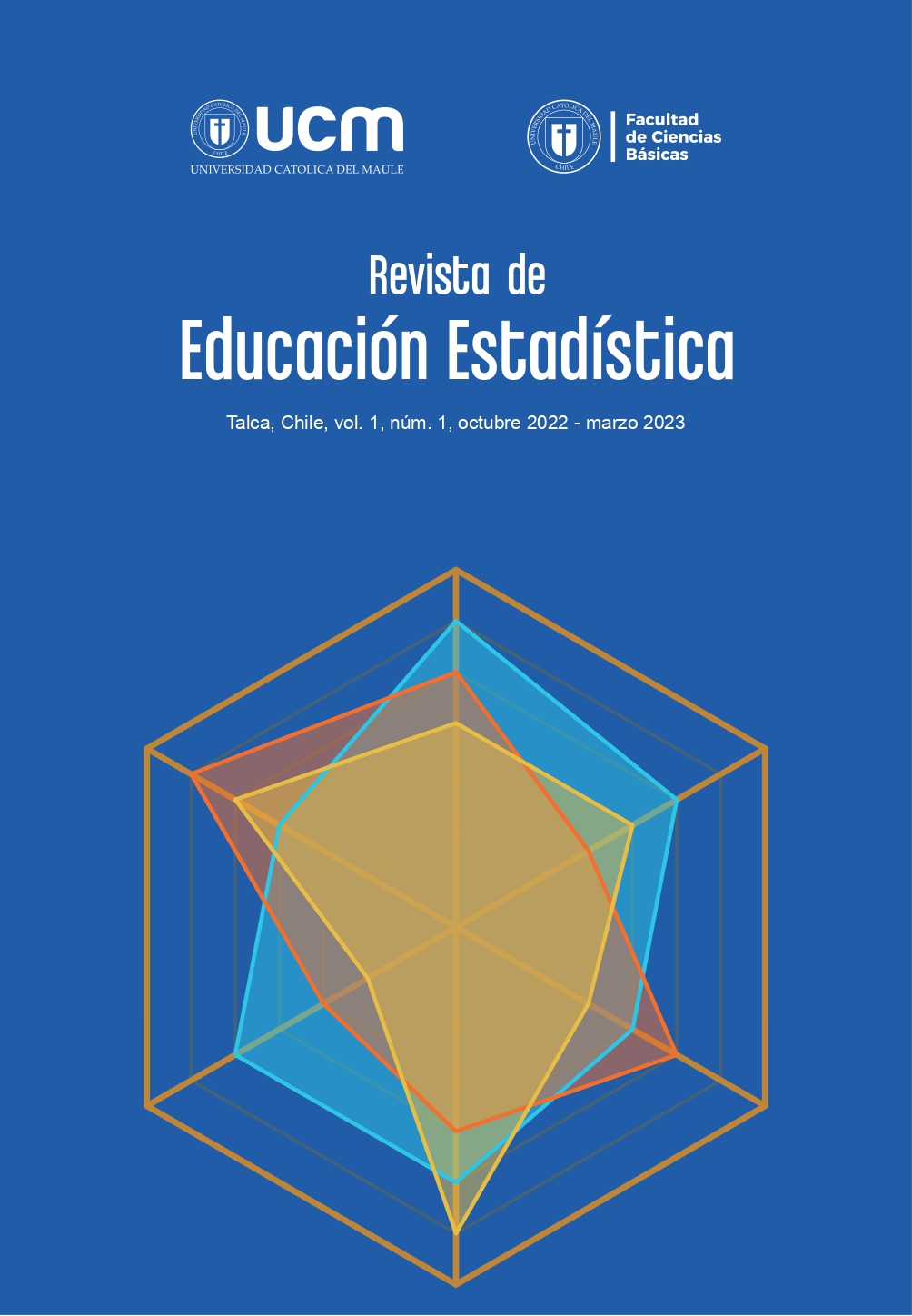Níveis de raciocínio sobre noções de amostragem em estudantes universitários: um estudo exploratório com estudantes mexicanos
Conteúdo do artigo principal
Resumo
Detalhes do artigo
Ainley, J. Gould, R. y Pratt, D. (2015). Learning to reason from samples: Commentary from the perspectives of task design and the emergence of “big data”. Educational Studies in Mathematics, 88(3), 405-412. https://doi.org/10.1007/s10649-015-9592-4
Begué, N., Batanero, C., Gea, M.M. y Beltrán, P. (2020). Comprensión de la representatividad y variabilidad muestral por estudiantes de educación secundaria. Yupana, 12, 8-22. https://doi.org/10.14409/yu.v0i12.9624
Begué, N., Batanero, C., Ruiz, K. y Gea, M. M. (2019). Understanding sampling: A summary of the research. Boletín de estadística e investigación operativa–BEIO, 35(1), 49-78.
Biggs, J. B. y Collis, K. F. (1991). Multimodal learning and the quality of intelligence behavior. En H. A. Rowe (Ed.), Intelligence: reconceptualization and measurement (pp. 57-76).Erlbaum.
Burrill, G. y Biehler, R. (2011). Fundamental statistical ideas in the school curriculum and in training teachers. En C. Batanero, G. Burrill y C. Reading (Eds.), Teaching statistics in school mathematics: Challenges for teaching and teacher education. A Joint ICMI/IASE study. (pp. 57-69). Springer.
Carver, R.H., Everson, M., Gabrosek, J., Horton, N.J., Lock, R.H., Mocko, M., Rossman, A., Roswell, G., Velleman, P.F., Witmer, J.A. y Wood, B. (2016). Guidelines for Assessment and Instruction in Statistics Education (GAISE) College Report 2016.
delMas, R., Garfield, J. y Zieffler, A. (2009). The tyranny of context. Trabajo presentado en el International Collaboration for Research on Statistical Reasoning, Thinking, and Literacy, Brisbane, Australia.
Gal, I. (2002). Adults’ statistical literacy: Meanings, components, responsibilities. International Statistical Review, 70, 1-51. https://doi.org/10.2307/1403713
Gómez-Blancarte, A. L., Rocha, R. y Chávez, R. D. (2021). A survey of the teaching of statistical literacy, reasoning and thinking: teachers’ classroom practice in mexican high school education. Statistics Education Journal, 20(2). https://doi.org/10.52041/serj.v20i2.397
Harradine, A., Batanero, C. y Rossman, A. (2011). Students and teachers’ knowledge of sampling and inference. En Batanero, C., Burrill, G. y Reading, C. (Eds.), Teaching statistics in school mathematics: Challenges for teaching and teacher education. A Joint ICMI/IASE study (pp. 235-246). Springer. https://doi.org/10.1007/978-94-007-1131-0_24
Heitele, D. (1975). An epistemological view on fundamental stochastic ideas. Educational Studies in Mathematics, 6(2), 187-205.
Inzunza, S. (2020). Fundamental statistical ideas in primary, secondary and high school mexican curriculum: reflections from the international perspective. En A.I. Sacristán, J.C. Cortés-Zavala Y P.M. Ruiz-Arias (Eds.), Mathematics Education Across Cultures: Proceedings of the 42nd Meeting of the North American Chapter of the International Group for the Psychology of Mathematics Education (pp. 1308-1311). Cinvestav, AMIUTEM, PME-NA. https://doi.org/10.51272/pmena.42.2020
Inzunza, S. e Islas, E. (2019). Análisis de una trayectoria de aprendizaje para desarrollar razonamiento sobre muestras, variabilidad y distribuciones muestrales. Revista Educación Matemática, 31(3), 203-230. https://doi.org/10.24844/em3103.08
Kahneman, D. y Tversky, A. (1982). Judgments of and by representativeness. En D. Kahneman, P. Slovic y A. Tversky (Eds.), Judgement under uncertainty: Heuristics and biases (pp. 117-128). Cambridge University Press.
Lee, H., Angotti, R. y Tarr, J. (2010). Making comparisons between observed data and expected outcomes: Students’ informal hypothesis testing with probability simulation tools. Statistics Education Research Journal, 9(1), 68-96. https://doi.org/10.52041/serj.v9i1.388
Moore, D. y Cobb, G. (2000). Statistics and mathematics: Tension and cooperation. The American Mathematical Monthly, 107(7), 615-630. https://doi.org/10.1080/00029890.2000.12005247
Nilsson, P., Eckert, A. y Pratt, D. (2018). Challenges and Opportunities in Experimentation-Based Instruction in Probability. En C. Batanero y E. J. Chernoff (Eds.), Teaching and Learning Stochastics, ICME-13 Monographs. (pp.51-71). Springer International Publishing. https://doi.org/10.1007/978-3-319-72871-1_4
Reading, C. y Reid, J. (2010). Reasoning about variation: rethinking theoretical frameworks to inform practice. En C. Reading (Ed.), Data and context in statistics education: towards an evidence-based society. Proceedings of the eighth international conference on teaching statistics, ICOTS 8. International Statistical Institute.
Rossman, A. (2008). Reasoning about informal statistical inference: One statistician’s view. Statistics Education Research Journal, 7(2), 5-19.
Ruiz, K. y Contreras, J.M. (2021). Understanding sampling by chilean secondary school students. Statistics Education Journal, 20(2), 1-12. https://doi.org/10.52041/serj.v20i2.383
Saldanha, L. y Thompson, P. (2002). Conceptions of sample and their relationship to statistical inference. Educational Studies in Mathematics, 51(3), 257-270. https://doi.org/10.1023/A:1023692604014
Sánchez, E. y Landín, P. (2014). Levels of Probabilistic Reasoning of High School Students About Binomial Problems. En E.J. Chernoff, B. Sriraman (Eds.), Probabilistic Thinking, Advances in Mathematics Education, (pp.581-597). Springer. https://doi.org/10.1007/978-94-007-7155-0_31
Secretaría de Educación Pública. (2017). Planes de Estudio de Referencia del Marco Curricular Común de la Educación Media Superior. Recuperado de https://www.gob.mx/cms/uploads/attachment/file/241519/planes-estudio-sems.pdf
Silvestre, E., Sánchez, E. e Inzunza, S. (2022). El razonamiento de estudiantes de bachillerato sobre el muestreo repetido y la distribución muestral empírica. Revista Educación Matemática, 34(1), 100-130. https://doi.org/10.24844/EM3401.04
Watson, J. (2004). Developing reasoning about samples. En D. Ben-Zvi y J. Garfield (Eds.), The challenge of developing statistical literacy, reasoning and thinking (pp. 277-294). Kluwer.
Watson, J. y Moritz, J. (2000). Development of understanding of sampling for statistical literacy. Journal of Mathematical Behavior, 19, 109-136.
Watson, J. y Kelly, B. (2005). Cognition and instruction: Reasoning about bias in sampling. Mathematics Education Research Journal, 17(1), 24-57. https://doi.org/10.1007/BF03217408
Wroughton, J. R., McGowan, H. M., Weiss, L. V. y Cope, T. M. (2013). Exploring the role of context in students’ understanding of sampling. Statistics Education Research Journal, 12(2), 32-58. https://doi.org/10.52041/serj.v12i2.303

Este obra está bajo una licencia de Creative Commons Reconocimiento-NoComercial-CompartirIgual 4.0 Internacional.

